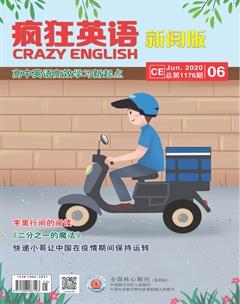Antarcticas pretty pink snow 南极“血雪”
李胜文


南极不少地方出现了“血雪”。这种看起来很吓人的红色不明物体,其实是极地雪衣藻,它呈现血红色是因为富含类胡萝卜素。这种红色的藻类,在温度低于水的凝固点时,会进入休眠状态,在气候变暖时,会大量繁殖。
1. drench /drent?蘩/ v. 使湿透
2. massacre /?謖m?覸s?藜k?藜(r)/ n. 屠殺
3. algae /?謖?覸lɡi?蘼/ n. 海藻;藻
A few weeks ago, scientists at Ukraine?蒺s Vernadsky Research Base in Antarctica awoke to find their usually white surrounds drenched in a shocking blood?鄄red.
From the gory?鄄looking images, you could be forgiven for wondering if there had been some sort of horror?鄄movie?鄄style penguin massacre. The good news is that the real cause is far less dramatic; unfortunately, it still has bad influences.
Marine ecologist Andrey Zotov from the National Academy of Sciences of Ukraine, captured these images.
“The snow had changed its color because of the tiny seaweed with a red carotene layer known as Chlamydomonas nivalis (雪地衣藻),” said the National Antarctic Scientific Centre of Ukraine in a Facebook post.
These microscopic green algae (we?蒺ll get to why they look red in a moment), a type of single?鄄cellular seaweed, are common in all icy and snowy regions of Earth, from the arctic to alpine regions.
They hibernate during the winter, but once the sunlight warms enough to soften their crystallised world, the algae spring awake, making use of the meltwater and sunlight to rapidly bloom.
“The algae need liquid water in order to bloom,” University of Leeds microbiologist Steffi Lutz told Gizmodo in 2016. The algal blooms contribute to climate change, the centre stated.
A study in 2016 showed that snow algal blooms can decrease the amount of light reflected from the snow (also know as albedo) by up to 13 percent across one melt season in the Arctic.
“This will result in higher melt rates,” the researchers wrote.
In 2017 environmental scientists calculated that microbial communities contributed to over a sixth of the snowmelt where they were present in Alaskan icefields. Their experiments showed that areas with more meltwater led to the growth of 50 percent more algae and places with more algae melted further.
This Antarctic summer has certainly seen a lot more meltwater than usual. Temperature records keep rising, leading to rapid melting at a scale previously only seen in the Northern Hemisphere.
1. What really caused blood?鄄red snow in Antarctica?
A. Too many penguins were killed.
B. The sunlight made it by mistake.
C. Some algae contributed to it.
D. The scientists did more experiments.
2. According to the researchers, what?蒺s the disadvantage of the algal blooms?
A. More ice and snow will melt.
B. More animals find few shelters.
C. Temperatures keep dropping.
D. It?蒺s unfit for scientists to research there.
3. What?蒺s the author?蒺s attitude towards blood?鄄red snow?
A. Approving. B. Doubtful. C. Cautious. D. Concerned.
Difficult sentence
From the gory?鄄looking images, you could be forgiven for wondering if there had been some sort of horror?鄄movie?鄄style penguin massacre.
【翻译】
【点石成金】本句是一个主从复合句。From...images是介词短语作状语,if引导宾语从句,作动词wonder的宾语。
- 疯狂英语·新阅版的其它文章
- The Secret Heart暗中的心
- Could laws designed to protect gig workers actually hurt them?保护“网约工”的法律引发争议
- The wolf at the door 饿狼临门
- Boy dresses up to honor school security officer五岁男孩“乔装”致敬校园安全卫士
- Scientists make new embryo of rare rhino species科学家再次培育出稀有犀牛胚胎
- What is life like in the US under this unprecedented situation 疫情下的美国生活

